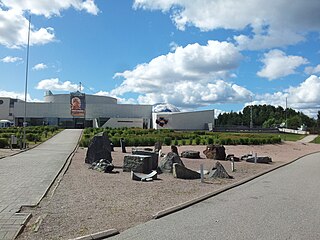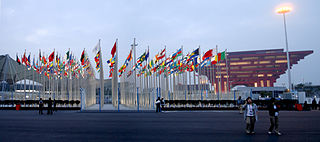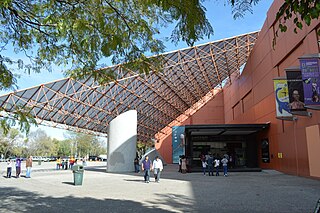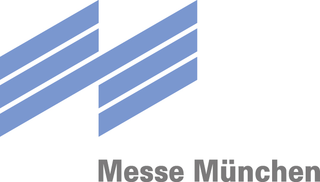
The Universum Bremen is a science museum in Bremen, Germany. Visitors are encouraged to interact with most of the approximately 250 exhibits. It receives on average 450,000 visitors annually. [1]

The Universum Bremen is a science museum in Bremen, Germany. Visitors are encouraged to interact with most of the approximately 250 exhibits. It receives on average 450,000 visitors annually. [1]
The Universum Bremen opened in September 2000 near to the University of Bremen, Germany. [2] Covering over 4,000 m² the exhibition contains exhibits related to one of the three topics: mankind, earth and the cosmos. The science center building, with its 40,000 stainless steel scales, resembles a mixture between a whale and mussel. It was designed by the Bremen architect Thomas Klumpp. [3]
The company Universum Managementges. mbH runs the science center as a private enterprise. About 3.4 million people visited the Universum in the first seven years since it opened.[ citation needed ]
In 2007 the Universum opened a large outdoor area, the EntdeckerPark, and a new building, the SchauBox. In contrast to the curved metallic older building, the SchauBox, developed by Haslob Kruse and Partner, is cubic with a rust-red exterior. It is used for additional exhibitions, which change annually. [3]
The EntdeckerPark, the 5,000 m² outdoor area developed by Planungsguppe Grün, offers a number of hands-on exhibits, landscape elements and a 27m-high tower, called the Turm der Lüfte.
The concept of the exhibits and the interior design were realized by Kunstraum GfK mbH, Hamburg and Archimedia, Stuttgart. [1]
The Oregon Museum of Science and Industry is a science and technology museum in Portland, Oregon, United States. It contains three auditoriums, including a large-screen theatre, planetarium, and exhibition halls with a variety of hands-on permanent exhibits focused on natural sciences, industry, and technology. Transient exhibits span a wider range of disciplines.

Expo 2000 was a World Expo held in Hanover, Germany from 1 June to 31 October 2000. It was located on the Hanover Fairground, which is the largest exhibition ground in the world. Initially some 40 million people were expected to attend the exhibition over the course of months; however, eventually with less than half of this number, the Expo was a flop and turned out to be a financial failure.

Heureka is a Finnish science center in the Tikkurila district of Vantaa, Finland, north of Helsinki, designed by Heikkinen – Komonen Architects. It is located at the intersection of the Finnish Main Line and the river Keravanjoki.

COSI, officially the Center of Science and Industry, is a science museum and research center in Columbus, Ohio. COSI was opened to the public on 29 March 1964 and remained there for 35 years. In 1999, COSI was moved to a 320,000-square-foot (30,000 m2) facility, designed by Japanese architect Arata Isozaki along a bend in the Scioto River in the Franklinton neighborhood. COSI features more than 300 interactive exhibits throughout themed exhibition areas.

Frederik Meijer Gardens & Sculpture Park is a 158-acre (64 ha) botanical garden, art museum, and outdoor sculpture park located in Grand Rapids Township, Michigan, United States. Opened in 1995, Meijer Gardens quickly established itself in the Midwest as a major cultural attraction jointly focused on horticulture and sculpture.

The Anchorage Museum is a large art, history, ethnography, ecology and science museum located in a modern building in the heart of Anchorage, Alaska. It is dedicated to studying and exploring the land, peoples, art and history of Alaska.

The EcoTarium is a science and nature museum located in Worcester, Massachusetts. Previously known as the New England Science Center, the museum features several permanent and traveling exhibits, the Alden Planetarium, a narrow-gauge train pulled by a scale model of an 1860s steam engine, and a variety of wildlife.
The MIT Museum, founded in 1971, is located at the Massachusetts Institute of Technology in Cambridge, Massachusetts. It hosts collections of holography, technology-related artworks, artificial intelligence, architecture, robotics, maritime history, and the history of MIT. Its holography collection of 1800 pieces is the largest in the world, though only a few selections from it are usually exhibited. As of 2023, works by the kinetic artist Arthur Ganson are the largest long-running displays. There is a regular program of temporary special exhibitions, often on the intersections of art and technology.

The Wild Center, formerly known as the Natural History Museum of the Adirondacks, is a natural history center in Tupper Lake, New York, near the center of New York state's Adirondack Park.
The North Carolina Museum of Natural Sciences (NCMNS) is the largest museum of its kind in the Southeastern United States. It is the oldest established museum in North Carolina, located in Raleigh. In 2013, it had about 1.2 million visitors, and it was the state's most visited museum or historic destination among visitors.

The Phillip and Patricia Frost Museum of Science is a science museum, planetarium, and aquarium located in Miami, Florida, United States. The museum originally opened its Coconut Grove location across from Vizcaya Museum and Gardens in 1960. It relocated to Museum Park in the downtown area adjacent to the Perez Art Museum Miami in 2017 after the closing of the Coconut Grove location in 2015.
Sciencenter is a hands-on science museum in Ithaca, New York. It was founded on February 28, 1983 as a 501(c)(3) not-for-profit educational organization. The Sciencenter grew out of the volunteer-run hands-on science program run for 15 years at several elementary schools in the Ithaca City School District. The community-based tradition continued as the museum grew to be nationally known, despite not having a paid staff until the 1990s. The Sciencenter is accredited by the American Alliance of Museums (AAM), and is a member of the Association of Science-Technology Centers (ASTC) and Association of Children's Museums.

Copernicus Science Centre is a science museum standing on the bank of the Vistula River in Warsaw, Poland. It contains over 450 interactive exhibits that enable visitors to single-handedly carry out experiments and discover the laws of science for themselves. The centre is the largest institution of its type in Poland and one of the most advanced in Europe. In 2018, since its opening, it has been visited by over 8 million people.

The Exploratorium is a museum of science, technology, and arts in San Francisco, California. It has been characterized as "a mad scientist's penny arcade, a scientific funhouse, and an experimental laboratory all rolled into one",. The participatory nature of its exhibits and its self-identification as a center for informal learning has led to it being cited as the prototype for participatory museums around the world.

The 2010 Taipei International Flora Exposition opened on 6 November 2010 and ran until 25 April 2011 in Taipei, Taiwan. It was a garden festival recognized by the International Association of Horticultural Producers and was categorized as an A2/B1 horticulture exposition. It was the first such internationally recognized exposition to take place in Taiwan, and the seventh of its kind to take place in Asia. It is located near Yuanshan Station. The area is now converted to Taipei Expo Park.

This article contains the details of the pavilions at Expo 2010. The 2010 World Expo Shanghai is the largest Expo site ever, covering more than 5.2 square kilometers and containing more than 70 exposition pavilions. More than 190 countries and 50 international organizations registered to participate in the 2010 Shanghai Expo. After the six-month run, the Expo had attracted well over 70 million visitors. The Expo 2010 is also the most expensive fair in the history of the World's Fair, with more than 45 billion US dollars invested by the Chinese Government.

Universum is Mexico's primary museum dedicated to promoting science and technology to the public as well as support the university's science missions. It was opened in 1992 at the Ciudad Universitaria in Mexico City. Today it has thirteen halls divided by theme dedicated to various permanent exhibitions. It has worked with outside public and private entities to develop both permanent and temporary exhibitions and has worked to develop other science museums in other areas of the country.

The Focke Museum is the museum of history and the history of art for the city and state of Bremen. It was formed in 1924 by the merger of a museum of industry and commerce and the previous historical museum, and is named for the founder of the latter, Johann Focke (1848–1922), a Bremen privy councillor and father of Henrich Focke. It is located in 4.5 hectares of grounds in the Riensberg neighbourhood of the city. In addition to a main building which opened in 1964 and was extended in 2002, the museum complex includes buildings dating from the 16th to the 19th centuries.

Messe München GmbH is the operator of the Neue Messe München exhibition center, the ICM Internationales Congress Center München and the MOC Veranstaltungscenter München. The exhibition space of the 16 halls together is 180,000 m2 and another 425,000 m2 of outdoor area, making Messe München by far the holder of the largest outdoor area of all exhibition companies in Germany. Messe München organizes some 40 trade fairs for capital and consumer goods and key high-tech-industries in Munich and abroad.